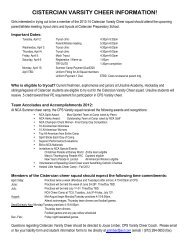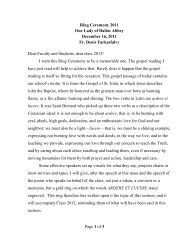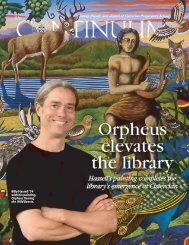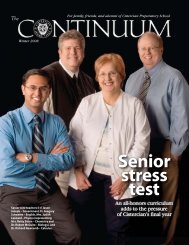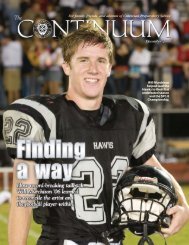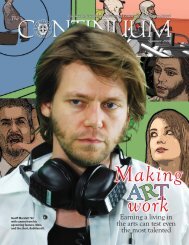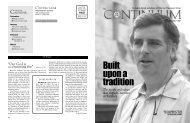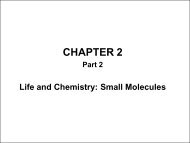Winter 09 Continuum FINAL.indd - Cistercian Preparatory School
Winter 09 Continuum FINAL.indd - Cistercian Preparatory School
Winter 09 Continuum FINAL.indd - Cistercian Preparatory School
- No tags were found...
Create successful ePaper yourself
Turn your PDF publications into a flip-book with our unique Google optimized e-Paper software.
ence’s tiny, claustrophobic room on a chilling day in November1956. There at a small table next to his bed, the novice master calmlyand delicately broached the conclusion of Br. Roch’s life in his belovedHungary.“There is a chance for you to go to Rome now,” Fr. Lawrencesaid, emphasizing this window might shut quickly. Br. Roch staredat him in disbelief.“But I would like to stay in Hungary,” pleaded Br. Roch, who hadjust completed his stint with the Hungarian People’s Army.“Even if the situation was normal,” Fr. Lawrence noddedknowingly, “I would send you toRome.”Br. Roch had attended the <strong>Cistercian</strong>school in Budapest (untilthe <strong>Cistercian</strong>s were banned fromteaching there in 1948) and becamea brother in 1951. The twoknew each other well.“I want you to be a theologian,”Fr. Lawrence explained.“My mother won’t want to letme go,” complained Br. Roch,who was living at home with hisfather, mother, and sister.“I will talk to her,” Fr. Lawrenceassured him.Fr. Lawrence, whose “day job”was translating technical texts fromRussian into Hungarian, visitedthe Kereszty home and compassionatelyexplained to Br. Roch’smother the extraordinary opportunitythat lay before her son.In light of the many sacrificesmade and the dangers faced by thissaintly man on behalf of her son,she found it impossible to refuse.With his mother’s approval, Fr.Lawrence instructed Br. Roch, “Tell them in Rome that you are thereto study theology and that you will return to Hungary after you’vecompleted your studies and the Soviets have left.” Then he added,“Don’t go to America.”As Fr. Anselm continued to share details of America and the Dallasfoundation, thoughts of Fr. Lawrence and his instructions continuedto fill the minds of the young monks.For them, the underground vicar embodied the flickering flameof Zirc.SOVIET AIRCRAFT, SNIPER FIRE, AND EXPLODINGbombs sounded all too frequently in Budapest between December1944 and February 1945. Hungary had tried its bestto stay out of the hostilities of World War II, but now, as theSoviets chased the Nazis back toward Germany, Budapest stood inthe way.The Siege of Budapest (December 29, 1944 – February 13, 1945)became known as one of the bloodiest sieges of World War II. Whenthe Soviets cut the German Army off at Budapest, Adolph Hitlerdeclared it a Fortress City, sacrificing the Hungarian capital in anattempt to slow the Soviet advance towards Vienna and Berlin.The <strong>Cistercian</strong> school, church, parishes, study house, and residencesin Budapest survived, having suffered relatively minor damage.But 80 percent of Budapest’s buildings were destroyed, leavingthe city with ruins and debris in its streets and the citizens withoutrunning water, electricity, or heat for months.While many hoped that life eventually would return to normaland the Soviets would tire of Hungary, history would show that thecountry in 1945 remained floating near the top of a long and suffocatingdownward spiral.Abbot Wendelin Endrédy instructedtwo priests to leave Hungaryin 1945. Fr. Anselm left firston an apparent assignment to continuehis studies in Rome. But afterFr. Raymund Molnár joined him inRome months later, the two traveledto America, to the small <strong>Cistercian</strong>monastery called SpringBank in Okauchee, Wisconsin.They served as the scouts for a possiblefoundation for the Hungarian<strong>Cistercian</strong>s in the Free World.In the aftermath of World WarII, the Soviet-installed governmentconfiscated property, including the<strong>Cistercian</strong> Order’s 40,000-acreestate, which had financed thevast operations of the Order (fromchurches and parishes to schoolsand missions).The days of Zirc as a freely operatinginstitution were numbered.Providentially, the Hungarian<strong>Cistercian</strong>s already had begunto undergo internal changes thatwould strengthen their ability andUNDERGROUND VICARFr. Lawrence Sigmond,novice master and vicar ofthe abbot of Zirc, played adangerous game with theSoviet regime to safeguardhis seminarians.their resolve to resist the Sovietonslaught.A Visitation of the Holy See in1937-38 had prompted new constitutionsand a new order of liturgy.Subsequently, liturgical monasticism(e.g., community prayer) becamean increasingly emphasizedpart of the <strong>Cistercian</strong>s’ daily lives.(Over the first three decades of the century, the <strong>Cistercian</strong>s’ work attheir urban schools, located far from the abbey in Zirc, had diminishedtheir monastic life.)After the death of Abbot Adolf Werner in 1938, the beloved44-year-old Fr. Wendelin would, as abbot, enthusiastically and prudentlylead the 200+ Hungarian <strong>Cistercian</strong>s toward this goal.The order’s “gentleman priests,” who had enjoyed a highly visiblesocial profile through their urban schools, would under the newabbot renew their commitment to community prayer life.FOR SEVERAL YEARS AFTER THE WAR, as the Sovietsworked to consolidate and organize their power, the <strong>Cistercian</strong> Orderin Hungary carried on, albeit with less pomp and circumstance.<strong>Winter</strong> 20<strong>09</strong>Photo courtesy of Abbot Denis Farkasfalvy11



